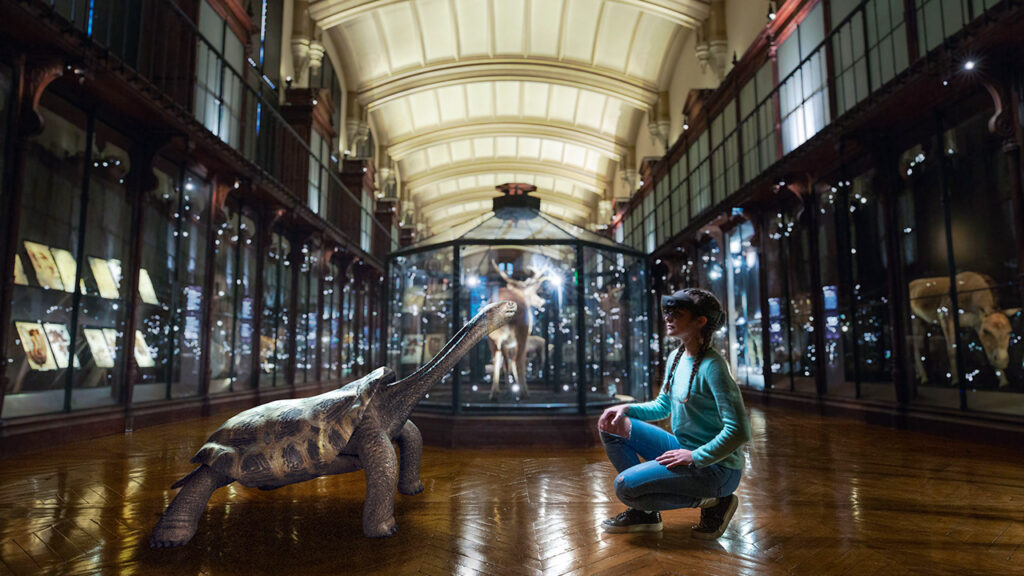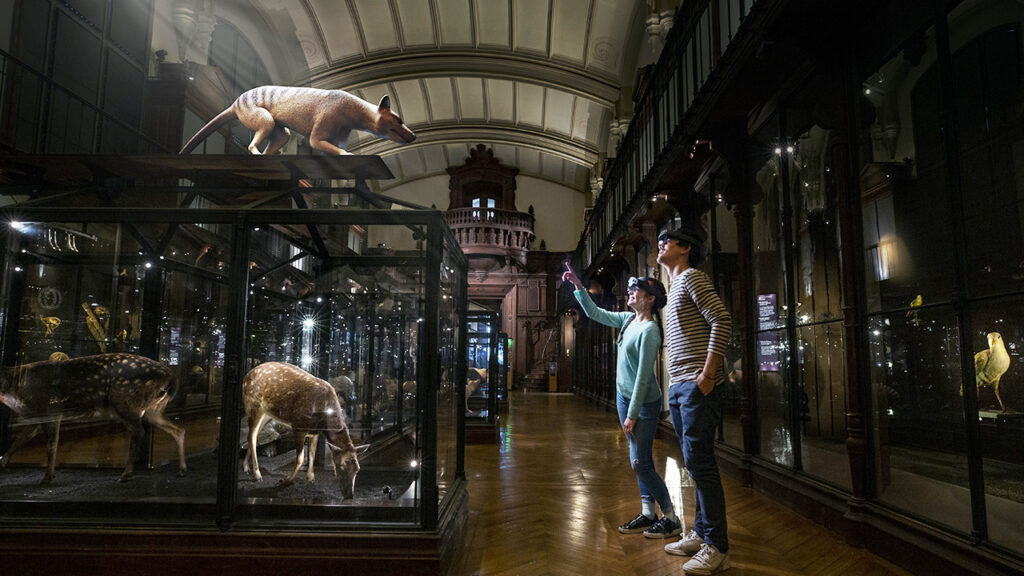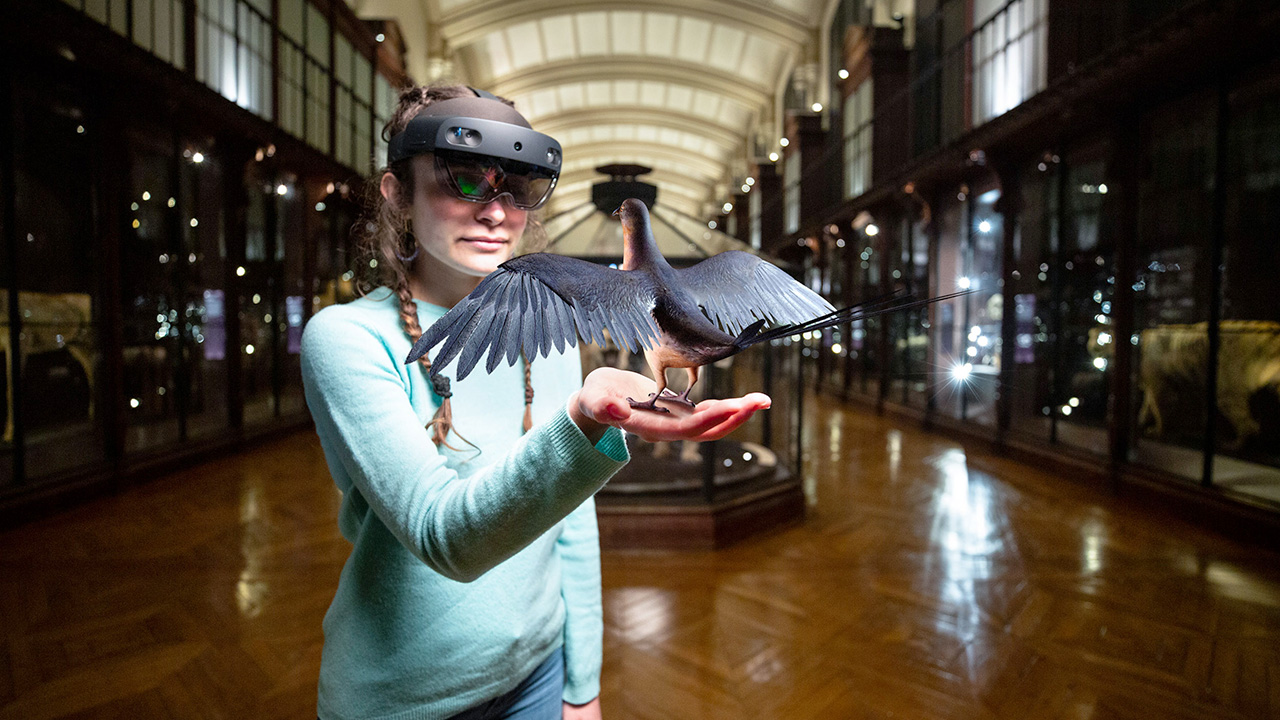It’s a story worthy of Spielbergian adaptation. Four years ago, filmmaker Jeremy Frey and his young daughter visited the French National Museum of Natural History (MNHN), where they strolled through the Grand Gallery of Evolution, which houses some 7,000 animal specimens. In a section of that vast hall, behind glass, sat models of endangered and extinct species from the dodo to the saber-toothed tiger — stuffed, silent, and still. What a pity, the girl reported to her father, that they could no longer witness these animals in motion.
Thus spurred, Frey would set about bringing these extinct animals, quite simply, back to life — no, not with ancient DNA, but with augmented reality (AR). Central to his endeavor is SAOLA, the France-based AR studio that he co-founded to build and realize the project, and that in due time, delivered. Revivre, a permanent AR installation, launched in mid-June in the MNHN’s Grand Gallery of Evolution, offering visitors up-close interactions with 11 extinct creatures, fully animated and in vivid color.
As experienced through Microsoft’s HoloLens 2 smart glasses, Revivre is intended to provide family fun, but also, emphasize environmental preservation. “We wanted to create an innovative and spectacular experience, but we wanted technology to be a tool, serving the message about preserving biodiversity,” Yann Kerbart, SAOLA’s Operation Manager, tells Jing Culture & Commerce.

While offering family-friendly entertainment, Revivre also sends a key message of biodiversity preservation. Image: SAOLA Studio / MNHN
While visitors commune with the long-decimated likes of thylacines, elephant birds, and Steller’s sea cows within the Grand Gallery, an audio guide backgrounds their habitats, contact with humans, and eventual disappearance. To ensure scientific accuracy throughout, SAOLA’s 30-person team relied on nature reporter Rémi Dupouy as much as MNHN’s body of documentation that includes drawings and testimonies. Six months of writing and research was followed by seven months of 3D modeling, rigging, animation, and rendering. “Each stage of creation,” notes Kerbart, “has been validated by museum experts.”
Realism, too, was key here. Kerbart highlights SAOLA’s use of a “precalculated technique” that though not widely employed in augmented or virtual reality (VR), allowed for “greater realism in renderings.” It’s a consideration that extends to the user experience itself. The choice of AR, as opposed to VR, was intentional to ensure “virtuality without being cut off from reality.” Though equipped with an AR device, visitors are meant to walk through the hall easily — “like a classic visit” — unhindered by distracting visual or audio cues.

The choice of AR, says Kerbart, was to ensure “virtuality without being cut off from reality.” Image: SAOLA Studio / MNHN
In fact, the Grand Gallery has an equal starring role in the experience. Being site-specific, the exhibition draws its audience’s eye to the historic hall’s spatial qualities and stately, cast iron-ringed architecture. No wonder, then, that the Parisian institution was “immediately enthusiastic” when pitched the idea for Revivre. “It’s a real collaboration, where everyone exercises their own skills,” says Kerbart of the studio’s partnership with MNHN. “We deliver the turnkey experience, and the museum manages the ticketing, communication, and onsite operations.”
Suitably, he’s evangelical about the entertainment and educational value AR technology can lend to venues. “AR is a great educational tool — fun, attractive, and very light in terms of logistics for museums,” Kerbart says. “By finding the right economic models, it is a technology that can also be affordable in terms of cost.”
And he wouldn’t be wrong: AR has been widely wielded by arts organizations over the past year as a way to diminish social distance, and as reopenings commence, continues to be tapped to reimagine zoos, walking tours, and New York’s High Line. Just as institutions might pursue a project like Revivre “for the purpose of highlighting their collections and renewing their audiences,” Kerbart adds, the museum-going public is seeking out exactly such unique experiences.
Indeed, AR adoption poses little to no barrier for an audience acclimatized to digital offerings and that, in driving demand, is fueling innovation in the field. “AR,” Kerbart insists, “represents the visitor experience of tomorrow.” Somewhere out there, a young Frey might concur.



